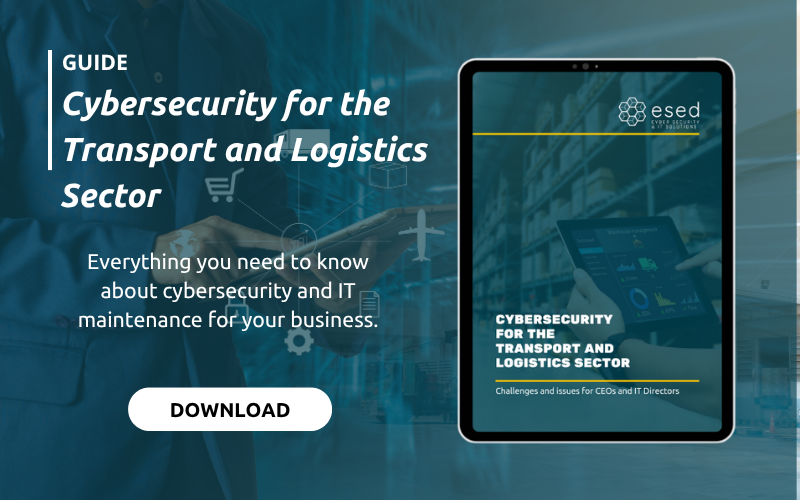Cybersecurity trends for the logistics sector
By Eduard Bardají on Oct 2, 2025 8:14:51 AM

In 2026, the logistics sector will continue to undergo an unprecedented transformation. The digitalization of warehouses, fleets, and traceability processes is making supply chains more efficient and connected, but also more vulnerable to cyberattacks.
Logistics operators manage critical information such as transportation routes, customer and supplier data, customs systems, and even information on sensitive cargo. This reliance on digital platforms, combined with the pressure to meet delivery deadlines and regulatory requirements, makes the sector a prime target for cybercriminals.
According to INCIBE, in 2023, the transportation and logistics sector accounted for up to 25% of cyberattacks on essential services, and in 2024 it became the third most targeted industry in Spain, surpassed only by other critical sectors. In addition, 71% of Spanish companies have suffered some form of cyberattack, and logistics is especially vulnerable due to its interconnection and digital dependence.
Most common cyberattacks in the logistics sector
- Ransomware: This malware encrypts company data, halting critical operations. A notable case was the attack on Logaritme, Catalonia’s main logistics center for medical supplies, which blocked its order system and compromised sensitive employee information. Losses from ransomware in logistics can exceed €50 million per incident.
- Phishing and social engineering: In 2024, Spain recorded over 21,000 phishing cases, many targeting logistics companies to steal credentials or divert shipments. These attacks cause significant financial losses and severely damage a company’s reputation.
- IoT device intrusions: Connected temperature sensors, GPS trackers, and monitoring systems expand the attack surface. Cybercriminals can manipulate data or access corporate networks, compromising the integrity of logistics operations.
An attack can paralyze the supply chain, disrupt distribution, and generate multimillion-euro losses. According to El País, in 2024, cyberattacks in Spain caused €10 billion in damages, with an average cost of €14.5 million per incident.
Key cybersecurity trends for the logistics sector
Segmentation of IT and OT Networks
In logistics, it is common for corporate networks (IT) to be connected to industrial or control systems (OT). Separating these environments through firewalls, VLANs, and access controls reduces the risk that an attack in an office could impact critical operations such as warehouse management or fleet tracking.
Continuous monitoring and early detection
Modern attacks often remain hidden for days before activation. Logistics companies will increasingly rely on 24/7 monitoring systems to detect irregular access, suspicious data transfers, or attempts to manipulate IoT sensors.
Identity and access management
The logistics sector depends on multiple actors: employees, carriers, external technicians, and partners. Implementing multi-factor authentication (MFA), least-privilege access, and access audits will be essential to protect critical data and systems.
Updating and patching connected devices
Logistics increasingly uses devices such as GPS sensors, RFID readers, scanners, and warehouse tablets. While essential for daily operations, these devices can become entry points for cybercriminals if not updated promptly.
By 2026, logistics companies are expected to adopt stricter update and patching policies, ensuring these devices receive regular security improvements without disrupting operations. Keeping them up to date is not just a technical task, it is a key measure to protect the supply chain and prevent incidents that could paralyze the business.
Cyberattack simulations
Logistics operators will begin conducting specific drills: ransomware attacks on transportation systems, customer data leaks, or failures in cargo sensors. These exercises help identify weaknesses and improve coordination across departments.
At ESED, we offer ESED ATTACK, our pentesting service designed to realistically and safely assess the security of a logistics company’s entire IT infrastructure. With ESED ATTACK, controlled attacks identify security gaps and potential entry points for cybercriminals, objectively evaluating system robustness without risking real operations.
To complement this protection, we also provide phishing simulations aimed at training and raising employee awareness, preventing the human factor from becoming a critical vulnerability for the company.

Ransomware protection
Ransomware will continue to be the main threat in logistics. Companies will strengthen response plans, backups, and network segmentation to minimize its impact. Attacks will become more selective, targeting critical links in the supply chain.
Managed cybersecurity
For many logistics companies, outsourcing security to specialized providers will be the most efficient way to ensure 24/7 monitoring, detection, and response without expanding internal resources. At ESED, we offer fixed monthly rates, allowing companies to plan their budgets without surprises.
You can quickly and personally calculate how much it would cost to protect your company using our cybersecurity budget calculator anytime.
By 2026, cybersecurity will no longer be purely a technical issue; it will become a key factor in competitiveness within logistics. Ensuring data integrity, operational continuity, and the trust of customers and partners will be essential for differentiation.
At ESED, we support logistics companies at every stage of their cybersecurity strategy, tailoring our solutions to the operational and regulatory realities of each organization. From 24/7 monitoring and detection, to ESED ATTACK, our pentesting service for identifying security gaps, and phishing simulations to train staff, we provide a comprehensive approach that protects both systems and company reputation.
Additionally, with our fixed monthly rates, companies gain access to continuous, scalable protection, with full cost control and without the need to expand internal resources. With ESED, cybersecurity stops being a concern and becomes a tangible competitive advantage, capable of anticipating threats, reinforcing customer trust, and ensuring that logistics operations never stop.
You May Also Like
These Related Stories

Consequences of not having cybersecurity in your company

Consequences of not investing in cybersecurity




.png?width=262&height=150&name=accio-10-negre%20(1).png)

